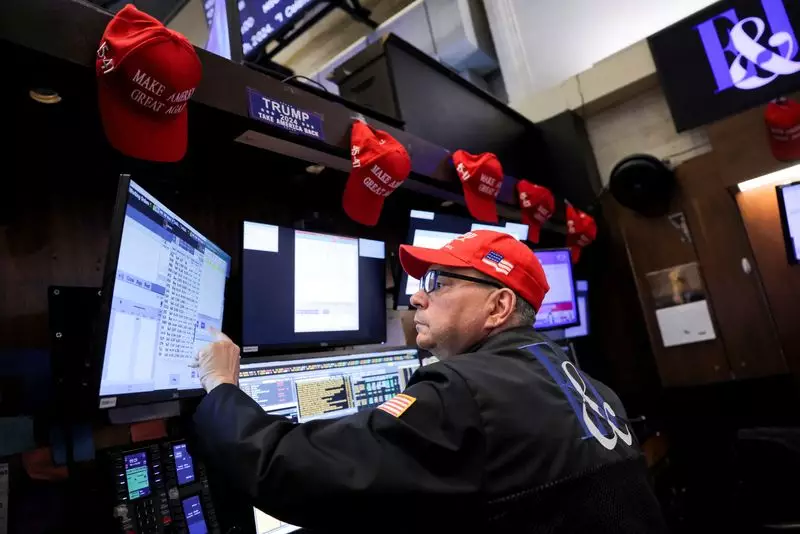In a surprising statement shortly after being elected, U.S. President-elect Donald Trump declared plans to impose significant tariffs on trade with Canada, Mexico, and China, marking a pivotal shift in trade policy that could reverberate throughout the global economy. Announcing a 25% tariff on goods from Canada and Mexico and an additional 10% on products from China, Trump’s aggressive trade stance has instantly attracted both attention and trepidation from market analysts and investors worldwide. This initial move appears to have instigated a rally in the dollar, while simultaneously triggering declines in equity markets across Asia and Europe. The implications of such tariffs could be far-reaching, particularly for sectors heavily reliant on exports and trade dynamics.
The announcement has led to immediate reactions within financial markets, with the Canadian dollar and Mexican peso reacting negatively against the dollar—a clear indication of the anxiety surrounding Trump’s impending policies. For instance, the Canadian dollar fell by 1%, while the Mexican peso slid by 2%, reflecting investors’ concerns about potential trade wars. According to Gary Ng, a senior economist at Natixis in Hong Kong, the shockwave from Trump’s announcement is particularly felt in Chinese assets, which may experience pressure as corporate profitability comes under threat due to the new tariffs.
Simon Yu, Vice General Manager at Panyao Asset Management in Shanghai, views tariffs as a fundamental bargaining chip in Trump’s negotiation strategy. Yet, he suggests that China may adapt its approach by accelerating moves towards self-sufficiency and reducing dependency on imported goods. This potential shift could result in long-term restructuring of supply chains and a reevaluation of trade partnerships, emphasizing the proactive steps nations may adopt in response to U.S. trade policies.
George Boubouras, Head of Research at K2 Asset Management, emphasizes the importance of recognizing that these tariff headlines, while alarming, are not yet concrete policies and might signal longer-term trends rather than immediate actions. He forecasts a steeper yield curve and a stronger dollar, suggesting that the ramifications of Trump’s trade policies could have more complex economic undercurrents. William Reinsch from the Center for Strategic and International Studies characterizes Trump’s stance as more of a threatening maneuver rather than a straightforward policy approach. This suggests that the negotiations may not result in the expected outcomes, which raises questions about the efficacy of such a confrontational posture in achieving trade goals.
Meanwhile, market analysts like Shoki Omori express caution, asserting that while the immediate reactions in currency markets are noticeable, the Mexican peso shows resilience, having already adjusted to the prospect of Trump’s presidency. This resilience could imply that investors have prepared for ongoing volatility and uncertainty rather than immediate collapse, signaling that the market may grow accustomed to Trump’s unpredictable trade policy maneuvers.
This trading environment reflects a resurgence of the anxious atmosphere of 2016, as remarked by Jason Wong, Senior Market Strategist at BNZ. It raises the prospect that market observers must brace themselves for a period of heightened volatility driven by Trump’s tweets and statements. Investors may find themselves caught in a cycle of reacting to fluctuating signals, echoing past experiences that have left many skeptical about the immediate implications of his announcements.
Khoon Goh from ANZ raises an intriguing point, questioning the enforceability of these tariffs from day one of Trump’s presidency. The conditional nature of these tariffs, tied to broader issues surrounding drug trafficking and migration, may hint at a more strategic approach to negotiations with Canada and Mexico rather than a fiscal ultimatum. This layering of conditions suggests that tariffs might operate as a bargaining tool rather than a definitive economic measure.
As market participants navigate these uncertain waters, the long-term implications of Trump’s trade policies remain clouded by ambiguity. With evaluations spanning initial reactions to macroeconomic forecasts, the question persists: will these tariff measures foster a more insular U.S. economy or ignite a broader trade fracas that impacts global supply chains? Ultimately, only time will reveal the true nature of Trump’s trade strategy and its consequences on both domestic and global economic landscapes, requiring astute vigilance from stakeholders across the board.

